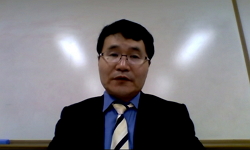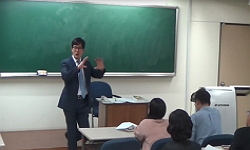본 연구는 공관복음서에 나타난 비유의 구조연구이다. 예수의 교훈에 사용된 방법들 중에서 가장 알려진 것은 비유이다. 이 비유는 배움의 과정에서 사람들을 창조적으로 열중사킨 가장 특...
http://chineseinput.net/에서 pinyin(병음)방식으로 중국어를 변환할 수 있습니다.
변환된 중국어를 복사하여 사용하시면 됩니다.
- 中文 을 입력하시려면 zhongwen을 입력하시고 space를누르시면됩니다.
- 北京 을 입력하시려면 beijing을 입력하시고 space를 누르시면 됩니다.
https://www.riss.kr/link?id=T7819589
- 저자
-
발행사항
서울 : 명지대학교 사회교육대학원, 2000
-
학위논문사항
학위논문(석사) -- 명지대학교 사회교육대학원 , 기독교교육학과 기독교윤리전공 , 2000. 8
-
발행연도
1999
-
작성언어
한국어
- 주제어
-
KDC
233.6 판사항(4)
-
DDC
226 판사항(20)
-
발행국(도시)
서울
-
형태사항
97p. ; 26cm.
- 소장기관
-
0
상세조회 -
0
다운로드
부가정보
국문 초록 (Abstract)
본 연구는 공관복음서에 나타난 비유의 구조연구이다. 예수의 교훈에 사용된 방법들 중에서 가장 알려진 것은 비유이다. 이 비유는 배움의 과정에서 사람들을 창조적으로 열중사킨 가장 특징적인 방법이다. 공관복음서에 나타나는 예수의 교훈의 35%이상이 비유의 형태를 지녔다. 비유(parabole)라는 말은 공관복음에서 만 48회 사용되고 있다. 비유의 헬라어 parabole의 본래의 의미는 ‘비교’, ‘대바’의 의미를 갖는다. 비유는 잘 알려진 자연이나 인간의 삶으로부터 새로운 진리를 조명하려는 의도를 가진다. 예수의 많은 이야기뜯은 흥미가 있고 그 가운데 진리를 포함하고 있다. 그는 비유의 자료를 자연에서 팔레스타인의 일상적인 삶에서, 일상적인 사건의 발생에서, 상징적인 사건에서 예외적인 상황에서 가져왔다. 그러므로 비유의 주제는 예수의 메시지의 주제와 살아 있는 상황에서 찾아야 한다. 따라서 이 비유를 바르게 이해하고 해석 적용하기 위해서는 비유가 갖는 기본적인 두 형식 즉 내부와 외부적 의미를 살펴보는 것이 본연구의 주안점이다.
이 목적을 위하여 본 연구는 다음과 같이 진행하였다.
제1장에서는 비유에 대한 연구의 방법을 위한 문제를 제기하여 보고, 특히 공관복음 안에서의 제한된 범위를 두고 여기서는 공관복음 전체적 내용에서 끌어낼 수 었는 비유의 목적을 이야기 해보려고 한다. 사실 비유 사용의 목적은 막4:11--12의 해명만으로는 충분하지 않고 그것이 사용되고 있는 공관복음서의 전체적인 맥락에서 검토되어야 할 것이다. 공관 복음서에 나타나 있는 예수의 비유에 대한 관심과 함께 왜곡되어 가는 비유에 대한 올바른 이해와 연구를 통해 참 의미를 제시하고자 한다. 또한 복음서의 양으로나 비유의 특성으로 보나 많은 자료를 제공해 주는 비유가 예수의 직접 가르쳐주는 말씀이기에 연구할 필요성과 가치가 있다.
제2장은 공관복음서 비유에 대한 올바른 이해를 위한 배경을 살펴보고자 한다. 비유의 바른 의미와 뜻을 밝히는 중요한 택스트는 역시 성경이다. 구약·신약에서 말하는 비유는 히브라어로논 5힐밍, 헬라어는 JtapaBoM이다. 따라서 비유의 용법과 그 내용은 굉범위하여 일반백성의 말에서, 속담, 조소의 말, 수수께끼, 이야가 또는 알레고리, 지혜의 말, 선닥을 포함한 예언자적 선포에까지 쓰여졌는데 성서에서 말하는 구체적인 의미들과 필요성을 연구해보고 그리고 비유의 사용하선 예수의 그 당시 사회 및 경제와 종교적 정황을 개괄해보고 그리고 비유의 분류를 통하여 주제별 및 배경을 중심으로 분류해보고자 한다.
제3장은 공관복음서 비유의 _-12조 인 내부 구조를 살펴보고자 한다. 내부 어떤 이야기에서든지 내용은 형식에 의하여 결정된다. 형식은 내용의 조직화이다. 내용은 형식으로 표현된다. 그러므로 형식의 변화는 내용의 변화를 초래할 수 었다. 이러한 까닭에 내용을 알기 위해서는 형식을 알 필요가 있다. 따라서 바유연구의 순서는 마땅히 첫째로, 비유의 외부구조
를 연구하고 둘째로 비유의 내부구조에 있어서 내용을 조직하는 형식을 연구하고 셋째로, 비유의 내용을 연구하는 것이 되어야 한다. 형식은 비유의 내부구조콸 형성한다. 또한 비유에 있어서의 이미지와 이를 바탕으로 하여 해석하는 원리들을 살펴 보고자한다.
제4장은 공관복음서 비유의 외부구조에서 특히 버유에 가장 가깝고 밀접하게 연결되어 있는 것은 도입부와 종결부이다. 본 연구에서는 단지 비유의 종결부 → 질문과 명령 그리고 “이와 같이" (ofrrflX;) 경구를 그리고 자세한 해석을 달고있는 비유 가 비유의 내용과 어떤 관계를 가지는지에 관해서 고찰하므로 비유의 구조를 이해하고자 한다.
제5장은 결론으로 예수께서 말씀으로 사용하선 비유의 구조를 집약하여 본 연구를 정리해 보고자 한다.
앞으로 더 연구되어져 이로 인하여 비유의 해석과 적용이 개혁주의적이며 복음주의적인 해석으로 예수 그리스도께서 원하시는 메시지인 복음이 풍성하고 올바르게 전달되어지고 연구되어져야 할 것이다.
다국어 초록 (Multilingual Abstract)
This thesis studied the Parable shown in the synoptic Gospels. Parable is the most general way in Jesus Teachings and the most specific way to absorb people in Teachings. More than 35% of Jesus Teachings in the synoptic Gospels is covered with this m...
This thesis studied the Parable shown in the synoptic Gospels.
Parable is the most general way in Jesus Teachings and the most specific way to absorb people in Teachings. More than 35% of Jesus Teachings in the synoptic Gospels is covered with this method; parable is used 48 times only in the synoptic Gospels.
The word Parable, originated Greek Parabole, has the meaning of comparison or contrast and has an intension to search the new Truth from general Nature or Human Life. Many stories of Jesus are as interest and as instructive; He had found the materials from Palestine common life, common happening, symbolic event, and exceptional accident. Therefore, to understand and apply this, Parable, we should study and the two basic formalities, the internal and the external meaning.
This study has the process as below;
Chapter 1 is to institute the way to study the Parable, and derive its purpose in the synoptic Gospels, not only on the line, but the whole text. Actually, only in the line 4:11~12, the purpose of Parable is not complete; it should examined throughout the synoptic Gospels.
Its to give the concern of Parables in Jesus Teaching and also to give the real meaning through the sound study and understanding of Parable that is to be distorting.
And the amount of Gospel and the characteristic of Parable make us to study Jesus Teaching cautiously.
In Chapter 2, we are going to study on the background that makes us to understand the synoptic Gospels properly. It is the Bible that is an important text which clarifies the correct meaning and idea of Parable. According to the Old Testament and the New Testament, Parable is ??? in Hebrew and παραβολ? in Greek. The use and contents of Parable were so various and wide that it was widely used in common expressions of the people, proverbs, puzzles, scornful expressions, tales or allegories, maxims, and divine proclamation including Oracles. So it will be necessary to study on the concrete meaning of Parable and its necessity, and summarize the social, economic, and religious situations where Jesus used Parables. And we will categorize Parables according to their subjects and backgrounds.
In Chapter 3, the inner structures of synoptic Gospels will be treated. There is no inner tale whose contents are not determined by its form. The form is the system that is constructed by the contents. The contents always have to be expressed in the form. The alteration of the form may give rise to the alteration of contents. So it is necessary to understand the form so as to know the contents. Therefore, the order of study on Parables must be as following:
First, study on the outer structures of Parables. Second, study on the form that is constructed by the contents. Third, study on the contents of Parables. Also, we will survey the image of Parable and the principles by which we analyze Parable based on the image.
In Chapter 4, we are to understand the structure of Parables by investigating just what relation the end part of Parable, which contains questions, commands, word of "like this"(ο?τω?), and detail analysis, has to the end part of Parable. The introduction and the conclusion parts, in the outer structure of synoptic Gospels Parable, are linked intimately to the Parable.
In Chapter 5, we summarize the sturcture of Parables that were used by Jesus and conclude this study.
And more reformative and evangelical analysis and application of Parable will be used for the sound preach of Jesus Gospel.
목차 (Table of Contents)
- 목차
- 標目次=iv
- 그림目次=iv
- 國文抄錄=v
- 제1장 序論=1
- 목차
- 標目次=iv
- 그림目次=iv
- 國文抄錄=v
- 제1장 序論=1
- 제1절 問題提起 및 硏究範圍=1
- 제2절 硏究의 必要性 및 目的=4
- 제3절 硏究의 方法 및 節次=6
- 제2장 共觀福音書 比喩의 배경=9
- 제1절 聖書 比喩의 定義=9
- 1. 舊約에 나오는 比喩=11
- 2. 新約에 나오는 比喩=15
- 3. 比喩 使用 目的과 特性=18
- 제2절 共觀福音書 比喩의 歷史的 背景=29
- 1. 팔레스틴의 地理와 社會風習=29
- 2. 예수 當時의 宗敎的 狀況=38
- 제3절 共觀福音書의 比喩分類=43
- 1. 比喩의 目錄=46
- 2. 比喩의 主題別 區分=49
- 3. 比喩의 背景的 區分=50
- 제3장 共觀福音書 比喩의 內部構=52
- 제1절 比喩의 內容과 型式의 關係=53
- 제2절 比喩의 이미지=54
- 제3절 比喩 解釋의 原理=64
- 제4장 共觀福音書 比喩의 外部構造=75
- 제1절 質問으로서의 終結部=76
- 제2절 命令으로서의 終結部=77
- 제3절 "이와 같이(oυ¨τωc¸)"로 終結되는 境遇=79
- 제4절 驚句를 終結部로 가지는 境遇=80
- 제5절 자세한 解釋을 달고 있는 比喩들=81
- 제5장 結論=86
- 參考文獻=88
- ABSTRACT=94












